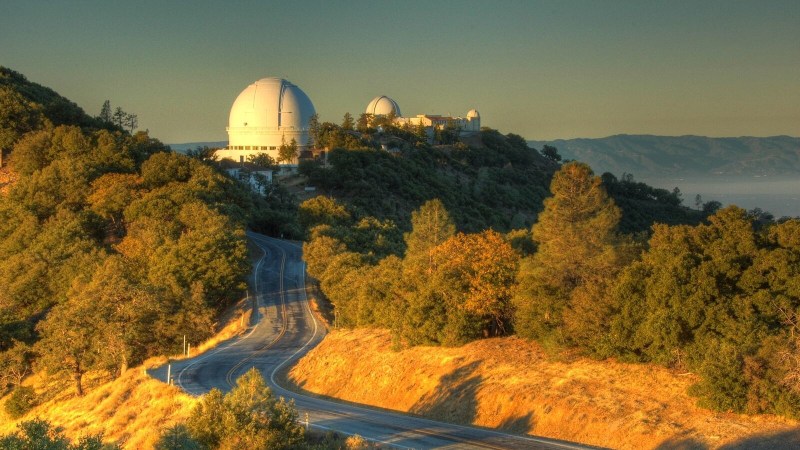Have 73 hours to kill and fancy a 4,609-mile road trip? Then you can check out some of the best observatories in the US (although we would probably recommend taking a couple of weeks rather than cramming the trip into three days, so you can spend at least one night stargazing at each).
Matador Network compiled a list of what they call the top ten US observatories, and published the daunting map you see above. Even if your trip is plagued by cloudy skies, rest assured the destinations will still be worth a visit. From Arizona’s Lowell Observatory, where the evidence Edwin Hubble used to formulate the Big Bang Theory was collected, to the Green Bank National Radio Observatory in West Virginia, home of Earth’s largest fully-steerable radio telescope, each site has incredibly rich history.
All of the observatories are open to the public in some way or another, but some are only accessible a few days per month, so make sure you plan your trip carefully! You may even want to travel with your own homemade telescope, Game Boy astrphotography rig, or, if you’re really dedicated, portable radio telescope.
[googlemaps https://www.google.com/maps/d/embed?mid=1L71ogpZmOaN7JQC-uKR37TVvEXMtevw&ehbc=2E312F&w=640&h=480%5D
















They missed The Owens Valley Radio Observatory which has monthly public tours:
https://www.ovro.caltech.edu/
When I was a graduate student at UT, Austin in the late 1970s and early 1980s, I visited McDonald a number of times. At that time. monthly public viewing was usually on the 106″ planetary telescope, but we managed to get spots on a night when the 82″ was used because the usual telescope was having its mirror resurfaced. The trapezium in Orion was the viewed object and it filled the field of view. At that time, such visits were free, if I remember correctly.
Some years later, in the mid 1980s, I took a friend with MS out to Big Bend to convince him that his disease did not prevent him from traveling. We ran into friends from the observatory’s PR staff at a hotel in Marathon and arranged to visit them later in the trip. When we arrived, we were informed that we had the 36″ for the night, if we wanted. It turns out that the staff had just added computerized pointing to the telescope and the computer technician, who was the official user for the night, was collecting corrections for the pointing equation. It did not matter exactly where we pointed it so long as we pointed it all over the sky. Seeing conditions were not good, jet stream overhead and a nearly full moon, but we saw a lot of clusters and double / triple stars. The moon was too bright to look at and there were no filters on hand, but closing the dome shutter to a narrow slit provided wonderful views. A bit after midnight, Jupiter rose and was spectacular. It appeared to be the size of a basketball seen from a distance of 10 feet or so.
I have been back several times since, stopping in for public viewing using a number of smaller instruments set up in the visitor center’s side yard, but nothing matches the views through the large instruments.
Thank you for the great story !
I guess you could average 63mph if you rotated drivers. But that is a heck of a cannonball run.
How is the Palomar Observatory, home of the 200″ Hale telescope, for many years the largest in the world, not on the list? Oh. Maybe because Matador Network is a travel organization, not a scientific one. From their article on the Green Bank National Radio Observatory, located in the National Radio Quiet Zone, where RF transmissions of pretty much any kind are prohibited: “but remember that there’s no GPS or cell phone signal if you get lost.” Apparently nobody told them how GPS works.
“Star observatories”? I think not, Space observatories is the correct term. There’s more than just stars out there you know.
In German, it’s “Sternwarte” (=Stern/star, Warte/watchtower). :)
Hubble was at Yerkes and Mt Wilson I thought, not Lowell.
Pretty sure you’re correct. He was recruited by Mt Wilson and also worked at Palomar. He may have visited Lowell, but I don’t believe he worked there on a regular basis. I used to hang out a lot at Wilson and befriended Don Nicholson who grew up on the mountain (given his father was an astronomer there) and ended up working there a majority of his life. He told me that Hubble was a real kook… he dressed like a Brit and attempted the accent often even though he was very American. Don was a great guy what little I knew about him. I’ll always cherish the times I spent with him learning little bits of history.
my 8th grade earth sciences teacher ran a really nice film on the msking of the 200″ at mt palomar.
she also got us into a nice loxal observatory, three mounts and all set were set up for us!
many years later now and im still gratefull for having her as my teacher